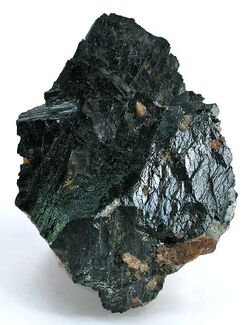Chemistry:Britholite-(Ce)
From HandWiki
| Britholite-(Ce) | |
|---|---|
 A photo of the mineral | |
| General | |
| Category | Mineral |
| Formula (repeating unit) | (Ce,Ca)5(SiO4)3OH |
| Crystal system | Hexagonal - Dipyramidal |
| Space group | P63/m |
| Identification | |
| Colour | Brown, greenish brown, yellow, resin brown, black |
| Mohs scale hardness | 5.5 |
| |re|er}} | Adamantine - Resinous |
| Specific gravity | 4.45 |
| Density | 4.45 |
| Major varieties | |
| hardness | 5.5 on the Mohs scale |
| type locality | Naujakasik(Naajakasik), Tunulliarfik Fjord, Ilímaussaq complex, Narsaq, Kujalleq, Greenland |
Britholite-(Ce) is a rare radioactive mineral with the chemical formula (Ce,Ca)
5(SiO
4)
3OH. It comes in a variety of different colors. Its type locality is Naujakasik (Naajakasik), Tunulliarfik Fjord, Ilímaussaq complex, Narsaq, Kujalleq, Greenland.
Discovery
The mineral was first discovered by Gustaf Flink in 1897 inside a nepheline-syenite at Naujakasik, Ilímaussaq complex, Greenland. It was named after the Greek word βρῖθος (brithos) which means "weight" referring to its high specific gravity, it was later named britholite-(Ce) due to the high amounts of cerium in its composition.[2]
References
- ↑ Warr, L.N. (2021). "IMA–CNMNC approved mineral symbols". Mineralogical Magazine 85 (3): 291–320. doi:10.1180/mgm.2021.43. Bibcode: 2021MinM...85..291W.
- ↑ "Britholite-(Ce): Mineral information". https://www.mindat.org/min-775.html. Retrieved 7 August 2020.
External links
 |

